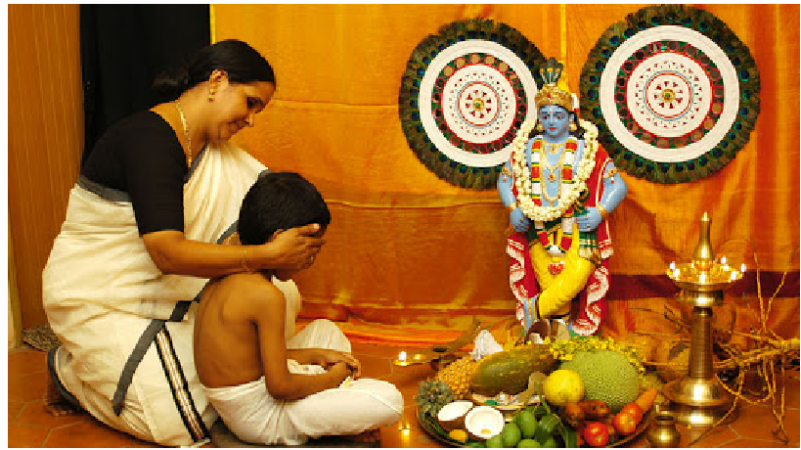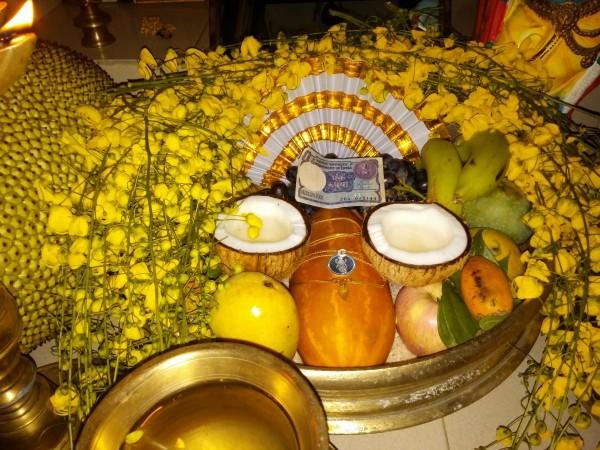Vishu, the beginning of the Zodiac New Year, is one of the most popular South Indian festivals that is widely celebrated in Kerala. Celebrated as the harvest festival, Vishu marks the beginning of the New Year. It is celebrated around the same time when the other similar harvest festivals like Baisakhi is celebrated in Punjab, Bihu in Assam, Poila Boishak in Bengal, Puthendu in Tamil Nadu and Vishua Sankranti in Orissa, and even Gudi Padwa in Maharashtra, Navreh in Kashmir, and Ugadi in Karnataka.

How is Vishu celebrated?
On the day of Vishu, usually on April 14 or 15, the women in Kerala prepare the grand Vishu kani, the quintessence of the day.
The Vishukkani represents the popular belief that seeing auspicious things on Vishu morning as the first sight of the day would bless the people with a very prosperous year ahead.
The kani usually comprises of items like white kasavu pudava (the typical Kerala kasavu saree), along with fruits and vegetables like kanivellari (golden coloured, shapely cucumber), vettila (betel leaves), mangoes, ripe yellow jackfruit, coconuts, a mirror (basically the Aranmula valkannadi), a brass kindi (a spouted puja vessel used for pouring sacred water), money (including coins and currency notes), rice in bowls, pulses, a nilavilaku (bronze oil lamp), an image of Lord Krishna and most importantly, the Konnappoovu (laburnum flowers). All these are placed well-arranged inside the pooja rooms by the day of Vishu.

The family members should open their eyes to this kani, on Vishu pulari or the morning of Vishu, thus imbibing all the goodness, prosperity and blessings for a fresh start in this new year. Each of these things placed in the kani symbolically represents prosperity and wellness.
The Vishu kaineettam is another fundamental of the day. The kaineetam or hansel given to the children by elders is a custom part of the day's celebration.
After this the children along with the adults, burst crackers which begins right from the previous night, and extends till the next. Known as "Vishu Paddakam" or the bursting of crackers, the fireworks are an integral part of the Vishu celebration, enjoyed by all big and small.

Another important aspect of the day apart from the Vishukodi (the new dress bought to be worn specially on the day), is the Vishu sadhya or the traditional feast.
The scrumptious feast that includes a wide array of dishes along with rice and payasams are served in the banana leaves. The heavily appetizing sadhya will have all the favourite dishes of Malayalis that comprise sweet, salty, sour and bitter items.
History of the celebration
Celebrated on the first day of Medam or the Malayalam month that marks the beginning of the new year, Vishu is the festival of harvest and productivity. Lord Krishna, the avatar of Lord Vishnu is worshipped on the day.

Historically, the day remembers the day when Lord Krishna killed Narakasura a demon. In another belief, Vishu is celebrated for the return of Surya Dev who was freed from the chains of Ravana, the demon.
Lockdown locks the celebration
With the nation-wide lockdown extended till the end of April, Malayalis are strictly prohibited from celebrating Vishu with any forms of pomp and show. Burning of crackers, visiting families are to be abandoned and the families are asked to celebrate the day, strictly by remaining in their homes.

















